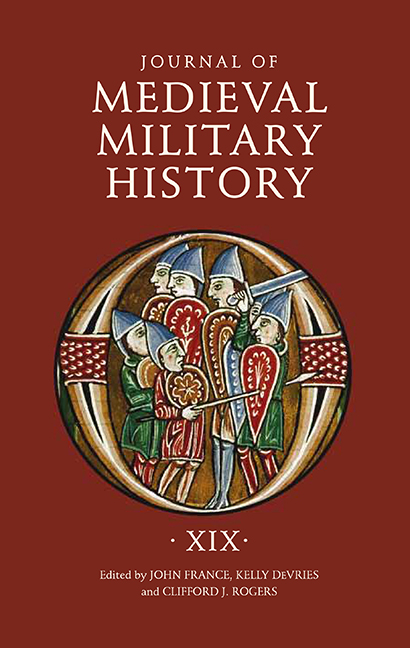Book contents
- Frontmatter
- Contents
- List of Illustrations
- 1 The Battle of Firāḍ: The Day on Which Khālid b. al-Walīd Did [Not] Defeat Both Byzantines and Persians
- 2 A Mislocated Battlefield? Battle Flats: The Battle of Stamford Bridge, 1066
- 3 The Frankish Campaign of 1133–1134 in Northern Syria and the Battle of Qinnasrīn
- 4 Bella Plus Quam Civilia? The Place of Battle in the Context of Civil War under the Anglo-Norman and Angevin Kings, c. 1100–c. 1217
- 5 Edward I’s War on the Continent, 1297–1298: A New Appraisal
- 6 The Earliest European Recipes for “Powder for Guns” (1336 and 1338–c. 1350)
- 7 Bellicose Rhetoric: The Memorable War Speeches of One Aragonese Royal Couple
- 8 Coureurs and Their Role in Late Medieval Warfare
- List of Contributors
- Journal of Medieval Military History 1477–545X
8 - Coureurs and Their Role in Late Medieval Warfare
Published online by Cambridge University Press: 02 June 2021
- Frontmatter
- Contents
- List of Illustrations
- 1 The Battle of Firāḍ: The Day on Which Khālid b. al-Walīd Did [Not] Defeat Both Byzantines and Persians
- 2 A Mislocated Battlefield? Battle Flats: The Battle of Stamford Bridge, 1066
- 3 The Frankish Campaign of 1133–1134 in Northern Syria and the Battle of Qinnasrīn
- 4 Bella Plus Quam Civilia? The Place of Battle in the Context of Civil War under the Anglo-Norman and Angevin Kings, c. 1100–c. 1217
- 5 Edward I’s War on the Continent, 1297–1298: A New Appraisal
- 6 The Earliest European Recipes for “Powder for Guns” (1336 and 1338–c. 1350)
- 7 Bellicose Rhetoric: The Memorable War Speeches of One Aragonese Royal Couple
- 8 Coureurs and Their Role in Late Medieval Warfare
- List of Contributors
- Journal of Medieval Military History 1477–545X
Summary
Horsemen described as coureurs are referred to frequently in contemporary accounts of the Hundred Years War and in chronicles and memoirs of the fifteenth and early sixteenth centuries. Mentioned in a variety of roles and guises, they have received some attention in secondary sources but have failed so far to receive a detailed and exhaustive examination of the part they played in late medieval warfare. The present article seeks to remedy this gap by an account of the origins of the term and those related to it, an examination of the tasks undertaken by coureurs, the men who filled their ranks, and the kinds of armor and weaponry they adopted. A central issue is whether they formed a discrete body within a late medieval army or were primarily defined by the roles they undertook. Contemporary accounts and later commentators do not always provide definitive answers to these questions. Nevertheless, clear categories of activity can be determined from existing sources, as well as conclusions relating to personnel and equipment. Finally, the article considers what happened to coureurs and how their functions were replaced by a more clearly defined light cavalry in subsequent centuries.
The sources for the Hundred Years War, particularly chronicle sources, contain hundreds of references to horsemen known as coureurs. Yet, they are not included in Philippe Contamine's index of the 178 different sub-classifications of combatants in Guerre, état, et société à la fin du Moyen Age, nor mentioned in his War in the Middle Ages. Clifford J. Rogers has briefly addressed their role in both Soldiers’ Lives through History: The Middle Ages, and “By Fire and Sword,” while Anthony Goodman has summarized the part played by “fore rydars” and “scourers,” their English counterparts, in The Wars of the Roses. Otherwise coureurs are seldom mentioned in secondary works. Indeed, a full examination of what the word coureur meant, who these soldiers were, and just what they did has not yet been undertaken.
Charles Oman considered that the French had no light cavalry until the Italian Wars (1494–1529) when chevau-légers developed following contact with Venetian stradiots. However, the French and English had experienced génétaires or jinetes, Spanish light horsemen based on those of Moorish origin, during the 1360s, while the Nicopolis campaign of 1396 had brought contact with Turkish and other light cavalry.
- Type
- Chapter
- Information
- Journal of Medieval Military HistoryVolume XIX, pp. 147 - 190Publisher: Boydell & BrewerPrint publication year: 2021



